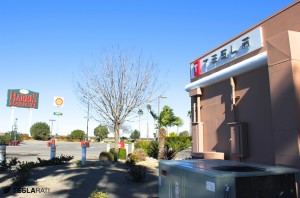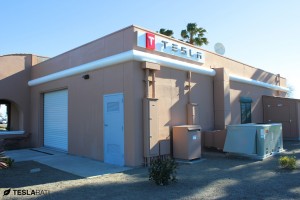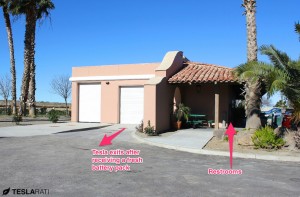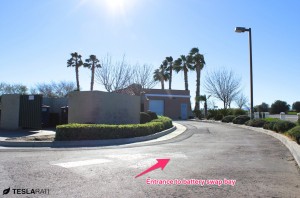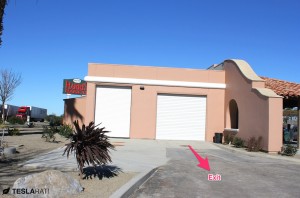News
Tesla shuts down battery swap program in favor of Superchargers, for now
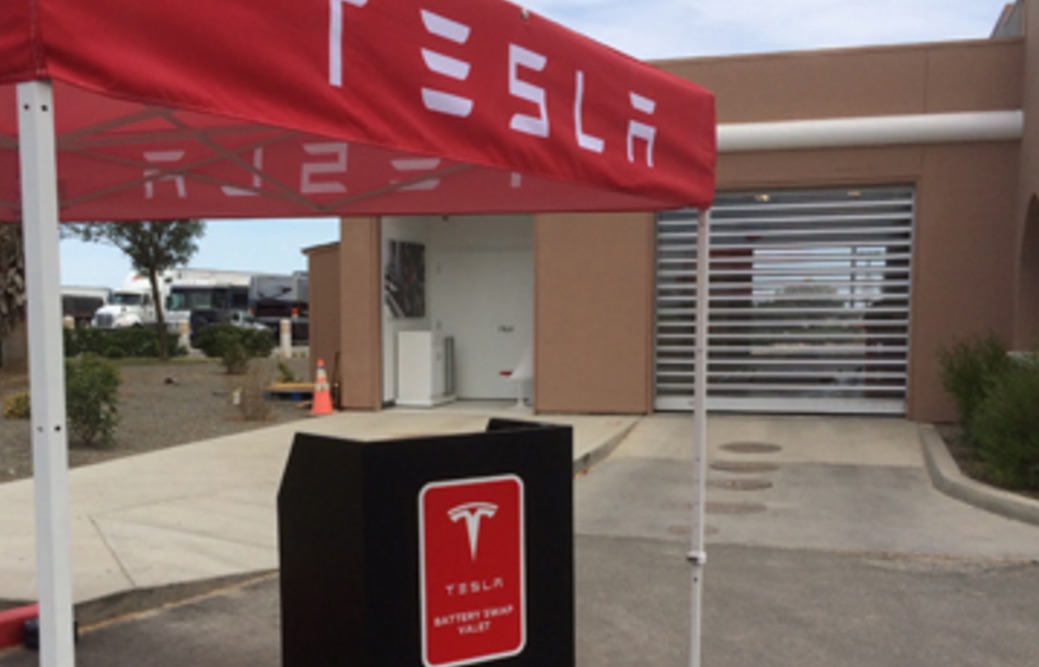
Tesla’s battery swap station near the Harris Ranch Supercharger station in Coalinga, CA seems to have been shut down, at least for now. What started out as a company vision to recharge Tesla vehicles in the same amount of time, if not quicker, as refueling a gas vehicle, turned into a pilot program that saw little to no fanfare.
Now, three years after Tesla first demonstrated the ability to quickly swap out the floor-mounted battery on a Model S and replace it with a fully charged battery pack, the company has seemingly closed the pilot program in favor of expanding its global network of Superchargers.
The news comes from a Tesla owner who had been following the development of the battery swap station off Interstate 5 (I-5) since its first debut. TeslaOwner accounts on their blog the experience with using Tesla’s battery swap program.
![Battery Swap station at Harris Ranch [Credit: TeslaOwner]](http://www.teslarati.com/wp-content/uploads/2014/12/141222enteringswap.jpg)
Battery Swap station at Harris Ranch [Credit: TeslaOwner]
TeslaOwner described the battery swap process as being a mix of machine and human. Any automation that occurred during the exchange was augmented by humans. Swap time was, on average, seven minutes. There was some trepidation that, upon returning the battery, a driver would receive a different battery with more accumulated mileage on it. Onboard technology did not recognize the swap and assumed that the original trip totals were continuing.
“Presently the Battery Swap Program is not accepting any new requests for appointments.”
Since experiencing the battery swap last July, TeslaOwner tells us that the same station has remained relatively quiet and “looked quite closed” each time they’ve driven by the station which appeared to have no activity.
This prompted them to inquire with Tesla about scheduling an appointment for another battery swap. According to TeslaOwner, they received a response from the Service Manager for the battery swap station, indicating that Tesla is no longer taking requests for appointments. “Presently the Battery Swap Program is not accepting any new requests for appointments.”
The viability of battery swaps moving forward
The Tesla proprietary charging station service was projected to be able to support both battery pack swaps as well as fast recharging of the Tesla Model S and Model X electric vehicle battery packs. By December 2014, 18 months after the original announcement, no battery swapping stations had yet opened to the public. Then a single battery-swap station was opened in California as a pilot project, where only invited Model S owners could do battery swaps by appointment, to assess technical and economic aspects of the service. Demand for the priced service would be used to determine whether the company would fully commercialize battery swapping stations more generally.
Photos captured of the Tesla battery swap station at Harris Ranch from December, 2014
By June 2015, the company had indicated that the battery swapping capability was no longer a significant part of Tesla’s plans for on-road energy replacement for their vehicles. Tesla’s standardization of car and the swapping stations alongside battery and battery fasteners prohibited other EV car owners from utilizing the battery swap station. For battery swapping to grow, the following conditions might need to be considered:
- Find strategic locations for battery swapping;
- Use alternative energy onsite to recharge batteries;
- Draw upon grid electricity when it is off-peak, cheapest, or when the more environmental energy generation is available;
- Assure customers that swapped batteries have comparable life expectancy in relation to the original;
- Incorporate fleet vehicles to reduce battery swapping costs overall.
The Tesla battery swap program doesn’t receive much press these days, given the news about the impending SolarCity merger and glass roof tiles, among the other constant Tesla technological innovations. Work on accelerating the rollout of Supercharger stations ahead of the Model 3 coming to market next year seems most critical. Moreover, regular Tesla owners at this moment in time don’t really seem to find the battery swap option as attractive as the Supercharger.
Of course, speculation continues to swirl. Tesla recently hired Audi’s North America commercial account manager to lead a new B2B push for Tesla in “fleet management, rental, government/public sectors & corporate enterprises.” Large commercial fleets of Tesla vehicles could change many aspects of the way that Tesla provides services, including a revisit to the battery swap with special, private fleet stations.

News
Tesla China delivery centers look packed as 2025 comes to a close
Needless to say, it appears that Tesla China seems intent on ending 2025 on a strong note.

Tesla’s delivery centers in China seem to be absolutely packed as the final days of 2025 wind down, with photos on social media showing delivery locations being filled wall-to-wall with vehicles waiting for their new owners.
Needless to say, it appears that Tesla China seems intent on ending 2025 on a strong note.
Full delivery center hints at year-end demand surge
A recent image from a Chinese delivery center posted by industry watcher @Tslachan on X revealed rows upon rows of freshly prepared Model Y and Model 3 units, some of which were adorned with red bows and teddy bears. Some customers also seem to be looking over their vehicles with Tesla delivery staff.
The images hint at a strong year-end push to clear inventory and deliver as many vehicles as possible. Interestingly enough, several Model Y L vehicles could be seen in the photos, hinting at the demand for the extended wheelbase-six seat variant of the best-selling all-electric crossover.
Strong demand in China
Consumer demand for the Model Y and Model 3 in China seems to be quite notable. This could be inferred from the estimated delivery dates for the Model 3 and Model Y, which have been extended to February 2026 for several variants. Apart from this, the Model Y and Model 3 also continue to rank well in China’s premium EV segment.
From January to November alone, the Model Y took China’s number one spot in the RMB 200,000-RMB 300,000 segment for electric vehicles, selling 359,463 units. The Model 3 sedan took third place, selling 172,392. This is quite impressive considering that both the Model Y and Model 3 are still priced at a premium compared to some of their rivals, such as the Xiaomi SU7 and YU7.
With delivery centers in December being quite busy, it does seem like Tesla China will end the year on a strong note once more.
News
Tesla Giga Berlin draws “red line” over IG Metall union’s 35-hour week demands
Factory manager André Thierig has drawn a “red line” against reducing Giga Berlin’s workweek to 35 hours, while highlighting that Tesla has actually increased its workers’ salaries more substantially than other carmakers in the country.

Tesla Giga Berlin has found itself in a new labor dispute in Germany, where union IG Metall is pushing for adoption of a collective agreement to boost wages and implement changes, such as a 35-hour workweek.
In a comment, Giga Berlin manager André Thierig drew a “red line” against reducing Giga Berlin’s workweek to 35 hours, while highlighting that Tesla has actually increased its workers’ salaries more substantially than other carmakers in the country.
Tesla factory manager’s “red line”
Tesla Germany is expected to hold a works council election in 2026, which André Thierig considers very important. As per the Giga Berlin plant manager, Giga Berlin’s plant expansion plans might be put on hold if the election favors the union. He also spoke against some of the changes that IG Metall is seeking to implement in the factory, like a 35-hour week, as noted in an rbb24 report.
“The discussion about a 35-hour week is a red line for me. We will not cross it,” Theirig said.
“(The election) will determine whether we can continue our successful path in the future in an independent, flexible, and unbureaucratic manner. Personally, I cannot imagine that the decision-makers in the USA will continue to push ahead with the factory expansion if the election results favor IG Metall.”
Giga Berlin’s wage increase
IG Metall district manager Jan Otto told the German news agency DPA that without a collective agreement, Tesla’s wages remain significantly below levels at other German car factories. He noted the company excuses this by referencing its lowest pay grade, but added: “The two lowest pay grades are not even used in car factories.”
In response, Tesla noted that it has raised the wages of Gigafactory Berlin’s workers more than their German competitors. Thierig noted that with a collective agreement, Giga Berlin’s workers would have seen a 2% wage increase this year. But thanks to Tesla not being unionized, Gigafactory Berlin workers were able to receive a 4% increase, as noted in a CarUp report.
“There was a wage increase of 2% this year in the current collective agreement. Because we are in a different economic situation than the industry as a whole, we were able to double the wages – by 4%. Since production started, this corresponds to a wage increase of more than 25% in less than four years,” Thierig stated.
News
Tesla is seeing a lot of momentum from young Koreans in their 20s-30s: report
From January to November, young buyers purchased over 21,000 Teslas, putting it far ahead of fellow imported rivals like BMW and Mercedes-Benz.

Tesla has captured the hearts of South Korea’s 20s-30s demographic, emerging as the group’s top-selling imported car brand in 2025. From January to November, young buyers purchased over 21,000 Teslas, putting it far ahead of fellow imported rivals like BMW and Mercedes-Benz.
Industry experts cited by The Economist attributed this “Tesla frenzy” to fandom culture, where buyers prioritize the brand over traditional car attributes, similar to snapping up the latest iPhone.
Model Y dominates among young buyers
Data from the Korea Imported Automobile Association showed that Tesla sold 21,757 vehicles to the 20s-30s demographic through November, compared to BMW’s 13,666 and Mercedes-Benz’s 6,983. The Model Y led the list overwhelmingly, with variants like the standard and Long Range models topping purchases for both young men and women.
Young men bought around 16,000 Teslas, mostly Model Y (over 15,000 units), followed by Model 3. Young women followed a similar pattern, favoring Model Y (3,888 units) and Model 3 (1,083 units). The Cybertruck saw minimal sales in this group.
The Model Y’s appeal lies in its family-friendly SUV design, 400-500 km range, quick acceleration, and spacious cargo, which is ideal for commuting and leisure. The Model 3, on the other hand, serves as an accessible entry point with lower pricing, which is valuable considering the country’s EV subsidies.
The Tesla boom
Experts described Tesla’s popularity as “fandom culture,” where young buyers embrace the brand despite criticisms from skeptics. Professor Lee Ho-geun called Tesla a “typical early adopter brand,” comparing purchases to iPhones.
Professor Kim Pil-soo noted that young people view Tesla more as a gadget than a car, and they are likely drawn by marketing, subsidies, and perceived value. They also tend to overlook news of numerous recalls, which are mostly over-the-air software updates, and controversies tied to the company.
Tesla’s position as Korea’s top import for 2025 seems secured. As noted by the publication, Tesla’s December sales figures have not been reported yet, but market analysts have suggested that Tesla has all but secured the top spot among the country’s imported cars this year.
